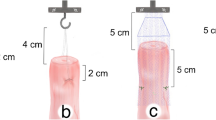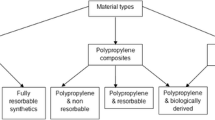Abstract
The aim of this study was the comparison of the stiffness of different meshes under two types of mechanical tests. Five different mesh types were mechanically tested. The methods used consisted on uniaxial tension test (tensile stiffness) and tape ring tests, experimental continuous compression of the mesh loops (flexural stiffness). The most significant difference of tensile stiffness behaviour appears between Aris™ and TVTO™. From the analysis of the experimental data, we divided the flexural stiffness, in two main groups. The first group includes Auto Suture™ and Aris™ meshes. The two meshes seem to have a similar flexural behaviour. The second group includes TVTO™, Uretex™ and Avaulta™. The difference between these two groups is clearly evident comparing TVTO™ and Aris™. This study shows that there are significant differences on the mechanical properties between urogynecology meshes.





Similar content being viewed by others
References
Wriggers P (2006) Computational contact mechanics, 2nd edn. Springer, New York
Weaver BT, Haut RC (2005) Enforced exercise after blunt trauma significantly affects biomechanical and histological changes in rabbit retro-patellar cartilage. J Biomech 38:1177–1183
Deffieux X, Tayrac R, Huel C, Bottero J, Gervaise A, Bonnet K, Frydman R, Fernandez H (2007) Vaginal mesh erosion after transvaginal repair of cystocele using Gynemesh or Gynemesh-Soft in 138 women: a comparative study. Int Urogynecol J 18:73–79
Petros PE (2007) Repairing damage fascia: ongoing and post operative considerations. In: Petros PE (ed) The female pelvic floor. Springer, Berlin, pp 108–156
Abdel-Fattah M, Sivanesan K, Ramsay I, Pringle S, Bjornsson S (2006) How common are tape erosions? A comparison of two versions of the transobturator tension-free vaginal tape procedure. BJU Int 98(3):594–598
Siegel AL (2005) Vaginal mesh extrusion associated with use of Mentor transobturator sling. Urology 66:995–999
Siegel AL, Kim M, Goldstein M, Levey S, Ilbeigi P (2005) High incidence of vaginal mesh extrusion using the intravaginal slingplasty sling. Urol J 174:1308–1311
Falconer C, Söderberg M, Blomgren B, Ulmsten U (2001) Influence of different sling materials on connective tissue metabolism in stress urinary incontinent women. Int Urogynecol J Suppl 2:S19–S23
Cosson M, Debodinance P, Boukerrou M, Chauvet MP, Pierre L, Crépin G, Ego A (2003) Mechanical properties of synthetic repair of prolapse and urinary incontinence which is the ideal material. Int Urogynecol J 14:169–178
Comiter CV, Colegrove PM (2004) High. rate of vaginal extrusion of silicone-coated polyester sling. Urology 63:1066–1070
Johnson & Johnson (2003) Nonabsorbable prolene soft mesh. Gynecare Gynemesh PS, p 2
Martins PALS, Jorge RMN, Ferreira AJM (2006) A comparative study of several material models for prediction of hyperelastic properties: application to silicone-rubber and soft tissues. Strain 42:135–147
Dietz H, Vancaillie P, Svehla M, Walsh W, Steensma A, Vancaillie T (2003) Mechanical properties of urogynecologic implant materials. Int Urogynecol J 14:239–243
Schumpelick V, Klinge U, Welty G, Klosterhalfen B (1999) Meshes within the abdominal wall (in German). Chirurgie 70:876–887
Fung YC (1993) Biomechanics: mechanical properties of living tissues, 2nd edn. Springer, Berlin, p 261
Moser AP (2001) Buried pipe design, 2nd edn. McGraw-Hill, New York, p 267
Fenner DE (2000) New surgical mesh. Clin Obstet Gynecol 43:650–658
Feifer A, Corcos J (2007) The use of synthetic sub-urethral slings in the treatment of female stress urinary incontinence. Int Urogynecol J 18:1087–1095
Neymeyer J, Abdul-Wahab W, Beer M, Spethmann J, Groneberg D, Große-Siestrup C (2007) Laboratory Testing of suburethral mesh slings: A comparison of their static and dynamic properties. Int Urogynecol J 18(Suppl 1):S111
Popov EP (1990) Engineering Mechanics of Solids. PRENTICE-HALL, chap. 6 Gynemesh or Gynemesh-Soft in 138 women: a comparative study. Int Urogynecol J 18:73–79
Deval B, Ferchaux J, Berry R, Gambino S, Ciofu C, Rafii A, Haab F (2006) Objective and subjective cure rates after trans-obturator tape (OBTAPE) treatment of female urinary incontinence. Eur Urol 49:373–377 (in Int Braz J Urol 33(1):101–124, January–February 2007)
Acknowledgments
This work was supported by CAPES (Federal Government of Brazil), and Ministério da Ciência, Tecnologia e Ensino Superior (FCT, Portugal) under the grant PTDC/SAU-BEB/71459/2006.
Conflict of interest statement
The work reported has not been supported by industry and the authors do not have conflict of interests.
Author information
Authors and Affiliations
Corresponding author
Additional information
An erratum to this article can be found at http://dx.doi.org/10.1007/s00192-007-0518-2
Rights and permissions
About this article
Cite this article
Afonso, J.S., Martins, P.A.L.S., Girao, M.J.B.C. et al. Mechanical properties of polypropylene mesh used in pelvic floor repair. Int Urogynecol J 19, 375–380 (2008). https://doi.org/10.1007/s00192-007-0446-1
Received:
Accepted:
Published:
Issue Date:
DOI: https://doi.org/10.1007/s00192-007-0446-1




